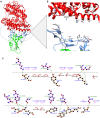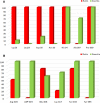An insight into the inhibitory mechanism of phytochemicals and FDA-approved drugs on the ACE2-Spike complex of SARS-CoV-2 using computational methods
- PMID: 33994655
- PMCID: PMC8106519
- DOI: 10.1007/s11696-021-01680-1
An insight into the inhibitory mechanism of phytochemicals and FDA-approved drugs on the ACE2-Spike complex of SARS-CoV-2 using computational methods
Abstract
The S-glycoprotein (Spike) of the SARS-CoV-2 forms a complex with the human transmembrane protein angiotensin-converting enzyme 2 (ACE2) during infection. It forms the first line of contact with the human cell. The FDA-approved drugs and phytochemicals from Indian medicinal plants were explored. Molecular docking and simulations of these molecules targeting the ACE2-Spike complex were performed. Rutin DAB10 and Swertiapuniside were obtained as the top-scored drugs as per the docking protocol. The MD simulations of ligand-free, Rutin DAB10-bound, and Swertiapuniside-bound ACE2-Spike complex revealed abrogation of the hydrogen bonding network between the two proteins. The principal component and dynamic cross-correlation analysis pointed out conformational changes in both the proteins unique to the ligand-bound systems. The interface residues, His34, and Lys353 from ACE2 and Arg403, and Tyr495 from the Spike protein formed significant strong interactions with the ligand molecules, inferring the inhibition of ACE2-Spike complex. Few novel interactions specific to Rutin-DAB10 and Swertiapuniside were also identified. The conformational flexibility of the drug-binding pocket was captured using the RMSD-based clustering of the ligand-free simulations. Ensemble docking was performed wherein the FDA-approved database and phytochemical dataset were docked on each of the cluster representatives of the ACE2-Spike. The phytochemicals identified belonged to Withania somnifera, Swertia chirayita, Tinospora cordifolia and Rutin DAB10, fulvestrant, elbasvir from FDA.
Supplementary information: The online version contains supplementary material available at 10.1007/s11696-021-01680-1.
Keywords: ACE2; FDA; Molecular dynamics; Phytochemicals; Spike protein.
© Institute of Chemistry, Slovak Academy of Sciences 2021.
Conflict of interest statement
Conflict of interestThe authors declare no conflict of interest.
Figures















Similar articles
-
Molecular docking study of potential phytochemicals and their effects on the complex of SARS-CoV2 spike protein and human ACE2.Sci Rep. 2020 Oct 19;10(1):17699. doi: 10.1038/s41598-020-74715-4. Sci Rep. 2020. PMID: 33077836 Free PMC article.
-
Targeting SARS-CoV-2 spike protein of COVID-19 with naturally occurring phytochemicals: an in silico study for drug development.J Biomol Struct Dyn. 2021 Oct;39(16):6306-6316. doi: 10.1080/07391102.2020.1796811. Epub 2020 Jul 22. J Biomol Struct Dyn. 2021. PMID: 32698689 Free PMC article.
-
Targeting COVID-19 (SARS-CoV-2) main protease through active phytochemicals of ayurvedic medicinal plants - Withania somnifera (Ashwagandha), Tinospora cordifolia (Giloy) and Ocimum sanctum (Tulsi) - a molecular docking study.J Biomol Struct Dyn. 2022 Jan;40(1):190-203. doi: 10.1080/07391102.2020.1810778. Epub 2020 Aug 27. J Biomol Struct Dyn. 2022. PMID: 32851919 Free PMC article.
-
Pathway enrichment analysis of virus-host interactome and prioritization of novel compounds targeting the spike glycoprotein receptor binding domain-human angiotensin-converting enzyme 2 interface to combat SARS-CoV-2.J Biomol Struct Dyn. 2022 Apr;40(6):2701-2714. doi: 10.1080/07391102.2020.1841681. Epub 2020 Nov 4. J Biomol Struct Dyn. 2022. PMID: 33146070 Free PMC article.
-
Molecular Dynamics Studies on the Structural Characteristics for the Stability Prediction of SARS-CoV-2.Int J Mol Sci. 2021 Aug 13;22(16):8714. doi: 10.3390/ijms22168714. Int J Mol Sci. 2021. PMID: 34445414 Free PMC article. Review.
Cited by
-
Identification and validation of shared gene signature of kidney renal clear cell carcinoma and COVID-19.PeerJ. 2024 Mar 4;12:e16927. doi: 10.7717/peerj.16927. eCollection 2024. PeerJ. 2024. PMID: 38464749 Free PMC article.
-
Evaluating therapeutic potential of AYUSH-64 constituents against omicron variant of SARS-CoV-2 using ensemble docking and simulations.Curr Res Struct Biol. 2024 May 31;7:100151. doi: 10.1016/j.crstbi.2024.100151. eCollection 2024. Curr Res Struct Biol. 2024. PMID: 38881558 Free PMC article.
References
-
- Alam N, Hossain M, Khalil MI, et al. Recent advances in elucidating the biological properties of Withania somnifera and its potential role in health benefits. Phytochem Rev. 2012;11:97–112. doi: 10.1007/s11101-011-9221-5. - DOI
-
- Case DA, Betz RM, Cerutti DS, Cheatham TE, III, Darden TA, Duke RE, Giese TJ, Gohlke H, Goetz AW, Homeyer N, Izadi S, Janowski P, Kaus J, Kovalenko A, Lee TS, LeGrand S, Li P, Lin C, Luchko T, Luo R, Madej B, Mermelstein D, Merz KM, Monard G, Nguyen H, Nguyen HT, Omelyan I, Onufriev A, Roe DR, Roitberg A, Sagui C, Simmerling CL, Botello-Smith WM, Swails J, Walker RC, Wang J, Wolf RM, Wu X, Xiao L, Kollman PA. AMBER 2016. San Francisco: University of California; 2016.
LinkOut - more resources
Full Text Sources
Other Literature Sources
Miscellaneous
